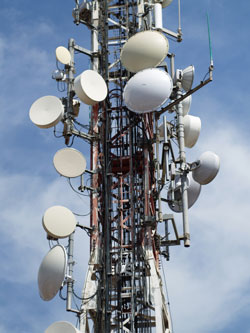We are a connected nation, except when it comes to out-of-the-way places. These include farms, country houses, businesses outside the city limits, new residential areas and some shopping centers. If they have a phone thanks to basic service, high-speed Internet access is less secure. This is where the wireless broadband provider or WISP fills the gap.
 Why WISP?
Why WISP?A WISP, or wireless Internet service provider, is similar to a cell phone service provider, but specializes in high-speed Internet access. While 4G cellular services also have relatively low usage limits, WISP services are much more permissive and try to mimic the type of service you'd get from cable, telecom or fiber optic lines. The real cost of connecting sparsely populated areas is burying bundles of cables or flying them over poles. WISP eliminates cables and associated costs. The downside is that you usually need a satellite dish and a small receiver to receive the WISP tower signal outside.
Where do WISPs get their bandwidth?
While WISP distributes bandwidth similar to WiFi, the bandwidth they serve has to come from somewhere. When the Internet was young, T1 lines did a great job serving WISPs as well as rural cell towers. The beauty of the T1 is that it can be sent over almost any distance over a standard twisted pair telephone cable. The downside is that the bandwidth is fixed at 1.5 Mbps per T1 line. Higher speeds can be achieved by adding or connecting additional lines to double, triple or quadruple the speed. The practical limit is around 10 to 12 Mbit/s. Prices increase linearly as you add each line.
Higher speed copper lines
A new technology that also works with double-pair copper is Ethernet over Copper (EoC). This service offers higher speeds, say 20 or 30 Mbit/s or even more. Transmission is limited by distance, but EoC is now more accessible outside city limits. The cost per Mbps is much more attractive than T1 if moderate speeds are sufficient for your needs.
Today, commercial cable broadband can deliver hundreds of Mbps, but has had very limited deployment outside of metropolitan areas. This changed somewhat as cable spread to remote subdivisions and commercial areas. If you can get this service and the cable company agrees to use it for a WISP, the cost will be very attractive.
fiber optic service
The new standard in broadband services is fiber optic. These were few and far between, but due to competition between providers, they are also common in rural areas. You can thank cellular 4G for the rollout of fiber optic lines in rural areas. Prices have come down dramatically with Ethernet over fiber (EoF) services. It's very reliable and easily scales bandwidth up and down to suit your needs. Bandwidths of 10 Gbps to 100 Gbps are common today.
microwave transmission
Why not wireless forwarding? This is not a far-fetched idea and is increasingly being used to upgrade telecom carriers to 5G towers. Microwave is a point-to-point wireless service. You mount a dish on your tower and point it at your service provider. It's like fiber but without the fiber.
SDN combines bandwidth
What if you need more bandwidth than a provider can provide? One way is to combine it with a technique called SDN or Software Defined Networking, also known as SD-WAN or Software Defined Wide Area Network. The SDN controller manages the traffic for the best performance of each packet. You can also combine T1, EoC, cable broadband, microwave, fiber optic and satellite internet to create a robust and faster power supply for your WISP tower.
Running or planning a WISP service? Find out now what bandwidth and prices are available for your desired locations. A friendly advisor will help you sort through the options.

Tidak ada komentar:
Posting Komentar